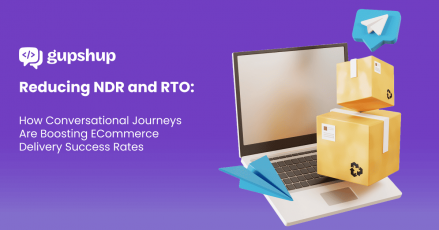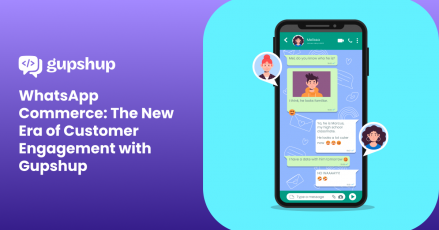Why Brands Should Leverage Multilingual AI Chatbots

“If you talk to a man in a language he understands, that goes to his head. If you talk to him in his own language, that goes to his heart.”
–Nelson Mandela
Multilingual AI…multilingual chatbot…multilingual AI bot platform…
In the world of customer support, these terms are cropping up with increasing regularity.
But what is multilingual AI?
Why should today’s brands consider multilingual AI for customer support?
What are the benefits of a multilingual AI bot platform?
In this detailed guide, we cover all these aspects of multilingual AI that brands often wonder about.
Human Language and Multilingual Artificial Intelligence
The world is a beautiful and diverse place – thanks to human language.
The 7+ billion people who occupy Planet Earth speak over 6000 languages. Although English is the most popular language of communication; it is still spoken by only 1 out of every 7 people around the world. Other languages like Arabic, Mandarin Chinese, Hindi, French, Spanish are also very popular and spoken in many countries apart from their country of origin.
Language matters.
More importantly, the right language for the right person matters even more.
This is particularly important in customer support. In countries where English is not the native language, companies and brands often struggle to engage with their audience if they cannot speak the audience’s language.
Likewise, customers also find it difficult to connect with companies or get the right kind of support, simply because the company provides support in a language that the individual cannot speak or understand. This results in disconnects and misunderstandings that adversely affect customer experiences, and ultimately have a negative impact on a company’s ability to attract and retain customers.
So what is the solution?
Hire a multilingual team of human customer support agents? Larger companies with a multinational presence and deep pockets can do this without much effort. But smaller companies with limited budgets and a geographically dispersed customer base cannot do this quite as easily.
For one, human support agents have limited expertise in other languages. While many people speak two languages (e.g. English and Hindi), those who speak three or more languages (trilinguals and polyglots) are fairly rare. So, for a U.S-based company with customers in England, Indonesia, India, Denmark and Ghana, it would be almost impossible to have an in-house human support team that can speak the native languages of all these countries.
Hiring remote support workers in multiple countries to engage with customers in that country’s native language is an option – with a large enough support budget. In addition to the costs involved, a multinational support team also creates technological, management and administration challenges that not all companies can easily overcome.
Multilingual AI (Artificial Intelligence) applications like chatbots provide the most optimal solution for these issues.
What is Multilingual AI?
Multilingual AI refers to AI that can converse with human users in multiple languages at once. For example, a multilingual chatbot can be set up to answer customer queries and engage with them in a language of their choice. Many chatbots are built and designed for specific markets or languages. While this enables brands to engage with many customers, they also end up excluding customers who don’t speak the chatbot’s language. Multilingual AI can help bridge this gap.
A conversational AI chatbot with multilingual capabilities can seamlessly switch between languages. It is “trained” to use and understand different languages, and also detect the languages that users are likely to use. It thus allows brands to reach a wider audience and provide support in a language that customers feel most comfortable with.
So, instead of being forced to converse in a non-native language that can create confusion, misunderstanding and frustration and thus affect customer experiences, customers can converse with the multilingual AI in a language of their choice to find answers to their queries and resolve their challenges in the shortest possible time.
Benefits of Multilingual AI
Multilingual chatbots and self-service options are vital to in-language support, which in turn is important for these reasons:
Accelerate Brand Growth
A recent report explained the strong connections between language accessibility and brand growth. Brands with highly localised offerings – whether in terms of product choice tailored to a unique demographic, currencies, payment options, website content or multilingual chatbots – tend to grow faster than brands that don’t offer localisation or language accessibility.
Break Down Language Barriers and Boost Sales
A chatbot that can only communicate in English (or some other default language) prevents brands from connecting with potential multilingual customers. This could threaten future sales, especially for brands that are targeting international markets where English is not the native language.
By making the AI chatbot multilingual, any company can easily connect with international buyers, educate them about its offerings, and guide them when they need help during the sales or after-sales process. By breaking down language barriers, a multilingual chatbot can ensure that there’s clear communication between the brand and its audience, which can boost sales and revenues, and also reduce the number of exchanges, returns or disappointed customers.
Improve Customer Experiences with Personalised, In-language Support
Research compiled by HubSpot reveals some interesting findings about customer experiences. For example, 60% of customers stop doing business with a brand after a single poor service experience. The good news is that 78% of consumers will do business with a company again after a mistake if the company provides excellent customer service overall.
Moreover, companies that prioritise better customer service experiences can grow their revenues by 4%-8% above competitors and improve their online conversion rate by 8% if they provide personalised consumer experiences.
Language is a big part of customer experiences, and providing support in the form of a multilingual chatbot can determine whether a customer has a good brand experience or a bad one.
Customer Demands for Self-Service
In 2019, research by SOTI found that 73% of polled customers preferred self-service which improves the shopping experience and reduces interactions with staff. Even as far back as 2017, HBR had reported that across industries, 81% of customers prefer to take care of issues themselves before reaching out to a live employee for help.
To accommodate such demands, brands must leverage next-gen self-service digital channels that ideally support both fully automated and hybrid (human+automated) self-service. These channels must minimise friction for customers, and enable them to reach their goals in the easiest possible way. And for this, a conversational AI chatbot with multilingual capabilities is ideal.
Enhance Customer Retention and Loyalty
A multilingual AI chatbot can quickly address customer concerns in their preferred language. So, instead of long queues and frustrating automated text; customers get fast answers and personalised support that help build trust and loyalty to the brand, which in turn positively impacts customer retention and repeat sales.
What can a Multilingual AI Chatbot Do for Customer Support?
A multilingual chatbot is the ideal first line of defence for customer support. It can greet customers, and resolve incoming support requests for common or frequently asked issues by pulling up help articles, sending links to appropriate web pages, or providing answers within the chat interface. It thus reduces the number of human agents required to support the brand’s full customer base, while ensuring that customers get fast, relevant answers without unnecessary delays or transfers.
If the issue is too complex for the bot to handle, it can collect relevant information, and automatically route customers to an appropriate human agent. Moreover, it can do all of this in the customer’s preferred language to ensure that the customer continues to feel comfortable, cared for, and understood.
Moreover, intelligent AI chatbots with multilingual capabilities can do more than simply answer questions. They can also:
- Engage visitors in contextual conversations to convert more website traffic into sales
- Generate more qualified leads
- Uncover important information about prospects and leads that human agents can then leverage to keep the sales pipeline moving
- Automate multiple business processes to save time, and reduce the cost of maintaining human agents
- Elevate the brand’s customer service by offering personalised support tailored to the user’s demographics, needs, and language
4 Types of Multilingual Chatbots
There are different kinds of multilingual AI/NLP chatbots that brands can leverage for their specific audience, languages, and use cases.
1. Simple Rules-based Multilingual Chatbots
Interactive FAQs and form-based interactions are two examples of such simple chatbots. In FAQ chatbots, a set of predefined keywords are mapped into the system. When a user enters a sentence that includes a predefined keyword in their language, the chatbot automatically directs them to the relevant localised information that’s related to the keyword.
A form-based chatbot works along similar lines. But in this case, the multilingual chatbot converses with the user, prompts them to provide information, and guides them as they fill out the form. Thus, a form-based multilingual chatbot feels more natural and human-like than a FAQ chatbot.
Both kinds of chatbots require content translations, transcreation of search keywords and phrases, predictions of keywords that human users are likely to use, and an understanding of human language patterns. The best multilingual AI technologies can also predict human “noise” variations, so the chatbot can not only understand one keyword, but also different variations of it to provide the most relevant answer in the user’s language regardless of the keyword used.
2. Complex Rules-based Multilingual Chatbots
These multilingual chatbots feel more human than simple chatbots, since they map human language inputs, add content-specific and context-specific information, and then engage in seamless dialogues with users.
Artificial Intelligence Markup Language (AIML), decision trees and cultural consulting are all vital for creating such chatbots. Using AIML, chatbot designers can define rules such as “If the user types A, convert it into B”. By normalising the user input, they can design the rest of the conversational flow in a way that feels human and natural to users.
In a complex rules-based multilingual chatbot, it’s also important to think about language patterns, syntax, grammar and word order since conversational rules differ by language, and the chatbot needs to consider these to converse with users in a wide range of languages.
3. Machine Learning Multilingual Chatbots
ML-based multilingual chatbots are trained with data and algorithms to learn new things, develop their language skills, and make inferences independently. The more they converse, the more they remember the things people say to them and recall this information to improve future interactions.
Such chatbots can solve problems and answer questions even if they have not been specifically programmed to do so. Moreover, their responses are more flexible and feel more like natural human conversations.
Intent-based ML chatbots can answer user queries based on a particular intention. Over time, the system can learn which query aligns with which intent to provide the best possible support in a human-like manner.
4. Complex Hybrid Multilingual Chatbots
Complex hybrid chatbots combine rules and machine learning. Rules help build grammar and syntax rules that the chatbot should follow as it converses with users. ML is used to build language models with Natural Language Understanding (NLU) capability, which enables the multilingual chatbot to understand users and user intent, and adapt their responses on-the-fly to engage in smooth, seamless conversations in the user’s preferred language.
Multilingual Chatbots and NLP
Multilingual conversational AI chatbots apply Natural Language Processing (NLP) technologies to understand and interpret human language inputs (text or speech) and respond to users using natural language. Before deployment, such chatbots are trained to understand customer sentiment, intent and needs for each language, and each unique use case.
Multilingual chatbots can interpret requests that customers make in their preferred language, engage in meaningful, contextual interactions to learn more about the customer’s query, and provide relevant responses to resolve that query.
Thus, AI and NLP enable intelligent multilingual chatbots to:
- Answer common queries in the customer’s preferred language
- Understand the query’s context, as well as any linguistic nuances, abbreviations, accents, and other cues
- React appropriately to the meaning of customer questions and statements
- Guide users down the sales funnel
- Transfer conversations to human support agents as needed
Further, multilingual chatbots, such as those developed using Gupshup’s low-code chatbot platform can not only support users in multiple languages but also support them on multiple channels, including:
- Website
- Slack
- Facebook Messenger
- Telegram
and more.
Multilingual Chatbots, BERT and Multilingual ML Models
BERT or Bidirectional Encoder Representations from Transformers is an open-source ML framework for NLP. Its goal is to help machines understand the meaning of language in the text. It does this by using surrounding text to establish context.
BERT is based on Transformers, a deep learning model that learns the contextual relationships between words in a piece of text. It was pre-trained using text from Wikipedia. However, since it was only trained on English text, this “monolingual” model cannot handle multiple languages simultaneously, which is what’s required with multilingual chatbots. To build such chatbots, the power of BERT-like models must be extended to languages other than English. Here’s where multilingual models come to the rescue.
Multilingual models are pre-trained on text coming from a mix of languages. For example, the XLM-R model is pre-trained on data from 100 different languages. Other multilingual models include:
- Multilingual BERT (mBERT): Trained on Wikipedia content with a shared vocabulary across all languages; supports 104 languages
- XLM: Can learn similar representations for different languages
The availability of multilingual models makes it possible to build multilingual chatbots. As these models are pre-trained on more text from more languages, in future, we can expect world-class multilingual chatbots that can engage in seamless, natural conversations with users in many different languages.
Why Use an AI Bot Platform
An AI bot platform like Gupshup enables developers, data scientists, and machine learning engineers to create and maintain multilingual chatbots for a wide range of use cases. By leveraging a platform, any brand can take advantage of ML and NLP capabilities to create chatbots that can converse with users in multiple languages naturally..
They can also integrate the chatbot into their website, social media platforms like Facebook Messenger, or a variety of chat applications like WhatsApp, Slack or Telegram to provide users with more options for multilingual support.
With Gupshup’s low-code bot-builder platform, brands can set up multilingual chatbots that:
- Accept voice and text data from users
- Understand user intent based on NLU
- Provide dynamic responses that adjust on-the-fly to fulfil user requests
- Deliver engaging user experiences and lifelike conversational interactions
- Customise conversations for specific use cases
- Integrate with third-party applications
Gupshup makes it easy to visually create, design, train, and test an AI-powered multilingual chatbot, without having to build NLP applications that require complex coding and back-end development.
Conclusion
Language should not be a barrier to your brand’s customer engagement and support efforts. It should not be a barrier if you’re looking to deliver personalised support and meaningful experiences to all your customers.
One study found that 68% of consumers said they had a positive experience interacting with chatbots. However, most customers prefer to interact with chatbots and have conversations in their native language. But chatbots that can converse in only one default language hinder customer experiences and prevent you from meeting your key goals.
If your customers live in different parts of the world and speak in different languages, you need a multilingual chatbot. Powered by AI and NLP and capable of conversing with customers in multiple languages, a multilingual conversational AI chatbot can be a game-changing addition to your customer support flows. However, creating a separate chatbot from scratch for each language is not feasible or cost-effective.
Gupshup’s enterprise chatbot building platform empowers organisations in all kinds of industries to build multi-language bots quickly and easily. The platform takes care of all coding and technical details, so you can easily add new languages to the chatbot as required, and deploy the chatbot on multiple channels as preferred by your customers.
To know how Gupshup’s multilingual chatbots can conduct conversations in multiple languages, and help you scale your localisation efforts and amplify your brand’s reach, talk to us. To know how Gupshup’s multilingual chatbots can conduct conversations in multiple languages, and help you scale your localisation efforts and amplify your brand’s reach, talk to us.
Alternatively, if you’re looking for low-code SMS, RCS or WhatsApp business solutions, explore our SMS API, WhatsApp API and RCS Business Messaging platforms. Gupshup also provides international OTP service. Contact us to discuss your needs.




